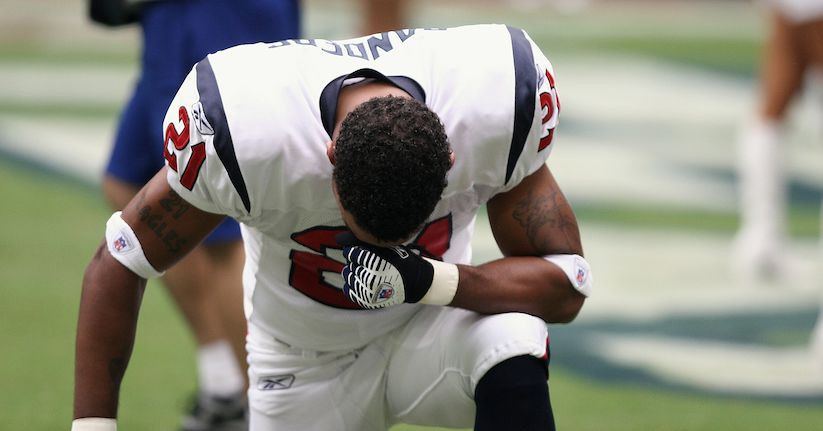After the NFL: Long-Term Damage of Concussions and Head Trauma
As the National Football League (NFL) continues to adapt on-the-field play in hopes of reducing significant injuries, the biggest issue remains the long-term impact of concussions and head trauma sustained by professional football players. And now recent studies have provided new insight into some of these concerns, including the prevalence of conditions such as migraine and chronic traumatic encephalopathy (CTE) after retirement.
Migraine
A recent pilot study of 50 retired NFL players revealed several important conclusions about life after football. First, more than 90% of all players included in the study reported head pain and other symptoms that fit the criteria for migraine; both episodic and chronic migraine were reported at significantly higher percentages when compared with the general adult male population as well. And the onset of the headache disorder typically occurred during their playing career or after retirement. Furthermore, many of these players also believed they had endured at least one concussion during their tenure in the NFL, which the researchers believe is a potential reason for its high occurrence.1 This is consistent with other studies that have shown significant impact from chronic migraine, especially those who also suffered concussions and other head trauma during their careers.2
In addition, the study authors reaffirmed other health and behavioral issues related to the headache disorder:1
- Light sensitivity and related symptoms as well as other sensory disruptions were key diagnostic factors.
- Incidents of depression and anxiety were also prominent, which have been linked with both migraine and light sensitivity. (You can read more about the link between anxiety disorders and sensitivity to light here.)
- In spite of the substantial impact due to their headache condition, many of the players were not actively receiving treatment—even when it could help.
Chronic Traumatic Encephalopathy (CTE)
Perhaps the most dangerous side effect of playing in the NFL is chronic traumatic encephalopathy, or CTE. According to the Concussion Foundation, CTE is a degenerative brain disease with physical, cognitive and emotional symptoms that result from multiple injuries to the head—which often occur years or even decades earlier. Recently, CTE was the main focus of Boston University researchers who established a clear connection that athletes do not need to endure a concussion to develop the brain disease; the simple act of experiencing repeated hits to the head may be enough to bring on CTE. The authors of the study even acknowledged that approximately 20% of those athletes with CTE were never previously diagnosed with a concussion.3
These findings come on the heels of a landmark study in July 2017, which showed that 99% (110 out of 111) of examined NFL players had signs of post mortem CTE.4 Perhaps none more notorious than Aaron Hernandez, a former NFL player who committed suicide after being convicted of first-degree murder in 2015. After his death two years later, it was discovered that Hernandez had one of the most severe cases of CTE, reported as “Stage 3” by medical researchers—which had not been previously observed in a brain younger than 46 years of age. Although many questions remain about how CTE may or may not have influenced his behavior, the story ignited national debate about the role of violence in sports.
In the fall of 2018, experts expanded on this study in an attempt to size up the potential risk of future CTE development among NFL players today. Although they acknowledge that estimates can be skewed for various reasons, they believe that at least 10% are likely to face the brain disease in the future—and the risk may be even higher.6
Chronic Pain
Given the physical nature of NFL games, it should not be surprising that chronic pain is also a significant part of the conversation post retirement. Studies have shown that as many 88% to 93% of former professional football players have ongoing pain on most days. Furthermore, four out of every five believe their pain to be either moderate or severe.1,5 And this pain could develop anywhere: neck, back, joints, hands, or feet. Unfortunately, this often can lead to the misuse of pain medication and opioids in an effort to reduce the pain. This can have auxiliary side effects as well, with countless evidence highlighting that medication overuse worsens headaches and migraine attacks.
A growing body of scientific evidence continues to put a spotlight on the risk of playing professional football in the NFL. Although the league has made significant strides in improving player safety and addressing longer term health concerns, these latest studies prove that there are still significant steps that need to be taken.
References:
1Evans R. The Prevalence of Migraine and Other Neurological Conditions Among Retired National Football League Players: A Pilot Study. Practical Neurology; Nov/Dec 2017.
2Conidi F. Incidence of Headache in Retired NFL Players. Correlation with Diffusion Tensor MRI Imaging and Neuropsychological Testing. Neurology Apr 2015, 84.
3Tagge C, Fisher A, Minaeva O, Gaudreau-Balderrama A, Moncaster J, Zhang XL, Wojnarowicz M, Casey N, Lu H, Kokiko-Cochran O, Saman S, Ericsson M, Onos K, Veksler R, Senatorov V, Kondo A, Zhou X, Miry O, Vose L, Gopaul K, Upreti C, Nowinski C, Cantu R, Alvarez V, Hildebrandt A, Franz E, Konrad J, Hamilton J, Hua N, Tripodis Y, Anderson A, Howell G, Kaufer D, Hall G, Lu K, Ransohoff R, Cleveland R, Kowall N, Stein T, Lamb B, Huber B, Moss W, Friedman A, Stanton P, McKee C, Goldstein L. Concussion, microvascular injury, and early tauopathy in young athletes after impact head injury and an impact concussion mouse model. Brain. 2018; 141(2):422-458.
4Mez J, Daneshvar DH, Kiernan PT, Abdolmohammadi B, Alvarez VE, Huber BR, Alosco ML, Solomon TM, Nowinski CJ, McHale L, Cormier KA, Kubilus CA, Martin BM, Murphy L, Baugh CM, Montenigro PH, Chaisson CE, Tripodis Y, Kowall NW, Weuve J, McClean MD, Cantu RC, Goldstein LE, Katz DI, Stern RA, Stein TD, McKee AC. Clinicopathological Evaluation of Chronic Traumatic Encephalopathy in Players of American Football. JAMA. 2017;318(4):360–370. doi:10.1001/jama.2017.8334.
5Cottler LB, Abdallah AB, Cummings SM, Barr J, Banks R, Forchheimer R. Injury, Pain, and Prescription Opioid Use Among Former National Football League (NFL) Players. Drug and alcohol dependence. 2011;116(1-3):188-194. doi:10.1016/j.drugalcdep.2010.12.003.
6Binney ZO, Bachynski KE. Estimating the prevalence at death of CTE neuropathology among professional football players. Neurology. 2019 Jan 1;92(1):43-45. doi: 10.1212/WNL.0000000000006699. Epub 2018 Nov 28.

TheraSpecs® Glasses for Light Sensitivity
Find the glasses that fit your needs and lifestyle, and stay protected from screens, fluorescents, unwanted blue light, sunlight, flashing lights, and more.
Shop Now



